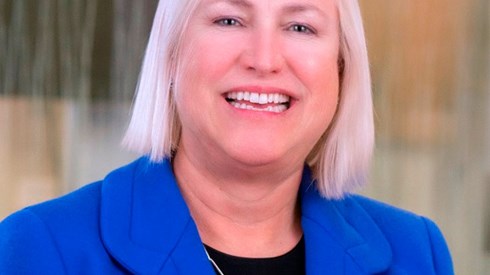Karin Landry: Captives Are the Whiteboard of the Insurance Industry

July 29, 2019

Karin Landry, managing partner at Spring Consulting Group in Boston, is a longtime recognized top leader in the area of funding employee benefit risks through captive insurance companies. Indeed, she has helped secure US Department of Labor (DOL) approval for many employers seeking to use this benefit funding approach. In an interview with Captive.com, Ms. Landry discusses a wide array of captive benefit issues, including the advantages of captive benefit funding, the status of a Labor Department freeze on captive benefit funding applications seeking rapid DOL review, and future growth of captive benefit funding.
For many years, employers have used their captives to fund employee benefit coverages, such as life insurance and long-term disability. To do this, an employer needs approval from the US Department of Labor. One way employers can get quick approval is through a regulatory procedure known as EXPRO (expedited procedure). Through this approach, an eligible employer can get DOL approval in just a couple of months, far faster compared to non-EXPRO. However, for many months now, DOL has frozen the use of EXPRO for captive benefit funding applications. Why did DOL take this action, and when do you see the freeze being lifted?
The Department of Labor reviewed EXPRO for captive insurance arrangements and made some changes to the program, particularly with respect to the required benefit enhancements. As a result, the DOL has adopted a more systematic approach to make EXPRO streamlined. We clearly heard that the DOL staff are more likely to examine benefits enhancements in applications. To the extent they vary, they may suggest the individual exemption process. They have started to consider new benefit captive applications.
In the meantime, do employers that want to fund benefits through their captives have an alternative approach to EXPRO?
Employers have always been able to fund non-Employee Retirement Income Security Act of 1974 (ERISA) plans like medical stop loss, deferred compensation, or voluntary benefits through captive insurers. We have definitely seen increased interest in these areas. If they underwrite other third-party risk, they can look at coming under the class exemption for benefits in captives. Depending on their structure, cell captive arrangements could be a viable option, but they should be carefully evaluated for the soundness of the program. An employer can also file an individual exemption application instead of an EXPRO application. Although the time frame is not dictated by the regulations, the process for an individual exemption is likely to vary somewhat from EXPRO.
Putting EXPRO aside, what are the advantages to funding employee benefits through a captive as opposed to just self-funding those coverages?
For programs subject to ERISA, most employers want to minimize employee disruption and continue to have their current carrier administer the program. Often, large insurers that are A rated (DOL requirement) may not offer a self-insured option. Additional advantages include improved risk management, increased control and ability to customize, and cost savings versus a fully insured program.
Do you expect more growth in the years ahead in the number of employers funding benefits through their captives and, if so, why?
Yes, I do expect more growth to come in the number of employers funding benefits through their captives. As the legislative landscape for captive insurance companies matures, funding benefits adds additional diversification to property and casualty captives and cost savings versus the commercial market.
Related to that, are there certain types of benefit risks that employers can fund through their captives without needing to first get DOL approval?
Yes, non-ERISA benefits like medical stop-loss coverage are an example of benefit risks that employers can fund through their captives without needing DOL approval.
Moving to another area, for many years, Vermont has been the largest domestic captive domicile, as well as the world's third largest. Do you see that changing in the years ahead?
The state of Vermont has always been and will continue to be at the forefront of the captive industry and its innovations. Other domiciles are certainly growing and adopting a forward-looking approach. There are a number of excellent captive domiciles—Arizona, Hawaii, South Carolina, Delaware, and many more—that give employers lots of options for selecting a domicile.
On the personal side, how did you get into the captive business? What did you do before joining Spring?
My educational background is in business and finance. Ultimately, this led to my interest being piqued by the insurance industry, where I found there were huge opportunities and interesting strategies using insurance to improve the financial health of an organization. This is even more true when it comes to captives. I started in the industry as a financial planner, then became senior consultant for Betterley Risk Services, and eventually came to manage my own firm, Spring Consulting Group. While my intellectual curiosity and ambition may have gotten me into the captive space, it's being able to go to the Cayman Islands each December (and call it work) and work with top professionals in the field that have gotten me to stay!
In all your years in the captive field, what has been your biggest surprise in the captive insurance industry?
Through all my years in the industry, I continue to be surprised by the sheer number of employers who can benefit from a captive insurance company but have never heard of the concept. As an example, we recently met with a large organization with over 10 related companies that had no idea what a captive is.
Looking ahead, what opportunities and problems lie ahead for the captive industry over the next 5 years?
I've always said that captives are the whiteboard of the insurance industry, with numerous possibilities just waiting to be drawn out. Specific opportunities I anticipate occurring in the next 5 years are as follows.
- Large, multinational corporations looking to utilize captives for more seamless and cost-effective implementation of their global insurance and benefits programs
- Continued growth in healthcare costs including the medical stop-loss trend, due to the aging of the workforce, a rise in pricing and uncertainty in the market, as well as the exorbitant prices of certain specialty drugs resulting in continued increase in medical stop loss in a captive
- The use of captives for related third-party risks that can then serve as a new line of revenue for organizations
- Increasing feasibility studies to make sure captives have the right risk optimization strategies and to determine their feasibility and the value to the organization
Captive insurance is now a well-established solution for risk financing. As captives continue to grow to represent an increasing share of the market, the legislative and regulative environments will continue to be a challenge for the captive industry. Many states may enter the captive market, while others may target the captive market for additional revenue.
How do you see the captive insurance regulatory landscape changing during that period?
As mentioned above, some captives may be revisiting their captive program including their domicile strategy as regulation changes. It is likely that some captives will receive additional scrutiny.
Any other comments you'd like to share with Captive.com readers?
I’d like to categorize my comments based on three different segments of people who may be reading this.
- For those who are experienced and successful in the captive space, remember that continuous reevalution of each captive, in light of the recent regulatory changes as well as the parent company's own growth and organizational shifts, is important to continued success. This regular review is a great opportunity for risk optimization.
- For those who are familiar with captives and are not participating in a program, know that they are a great tool for mitigating risk. Be sure to find the right advisers to help you with the process.
- For those with only a limited understanding of captives but who are considering it as a path for their organization, I urge you to take the time and effort to do your due diligence on captives before establishing a program. When it is set up properly, a captive can provide huge benefits for an organization over the long term. Keep in mind that sometimes getting out of your comfort zone will yield the best results.
(Article photo of Karin Landry is provided courtesy of Spring Consulting Group .)
July 29, 2019




